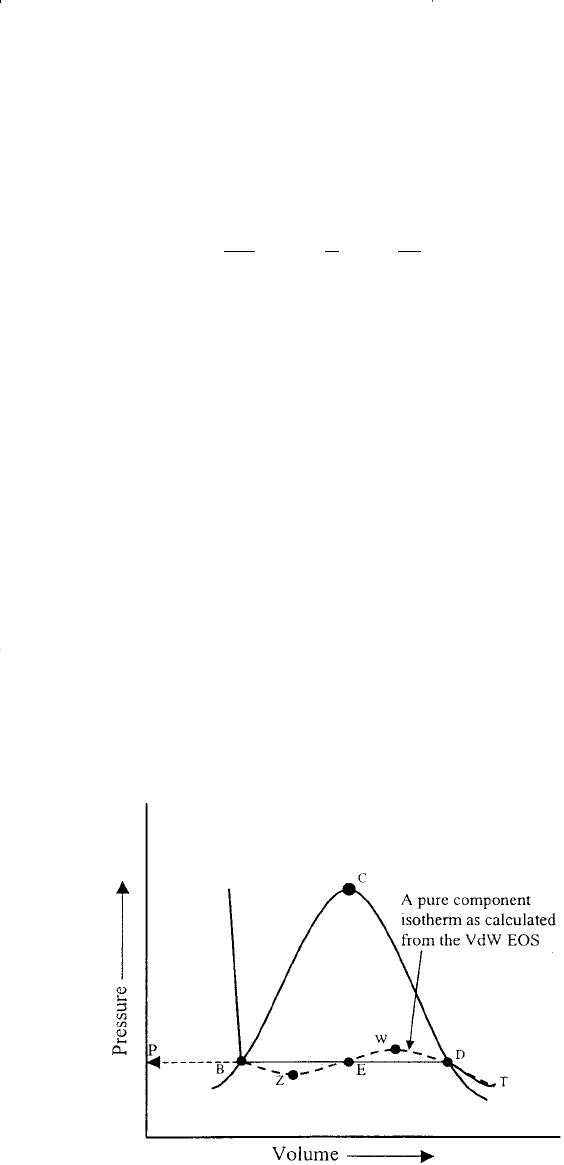Tarek Ahmed. Reservoir engineering handbook
Подождите немного. Документ загружается.


Equation 15-45 can also be expressed in a cubic form in terms of the
volume V as follows:
Equation 15-54 is usually referred to as the van der Waals two-parameter
cubic equation of state. The term two-parameter refers to the parameters a
and b. The term cubic equation of state implies an equation that, if expand-
ed, would contain volume terms to the first, second, and third power.
Perhaps the most significant feature of Equation 15-54 is its ability to
describe the liquid-condensation phenomenon and the passage from the gas
to the liquid phase as the gas is compressed. This important feature of the
van der Waals EOS is discussed below in conjunction with Figure 15-13.
Consider a pure substance with a p-V behavior as shown in Figure
15-13. Assume that the substance is kept at a constant temperature T
below its critical temperature. At this temperature, Equation 15-54 has
three real roots (volumes) for each specified pressure p. A typical solu-
tion of Equation 15-54 at constant temperature T is shown graphically
by the dashed isotherm: the constant temperature curve DWEZB
in Figure 15-13. The three values of V are the intersections B, E, and D
on the horizontal line, corresponding to a fixed value of the pressure.
This dashed calculated line (DWEZB) then appears to give a continuous
Figure 15-13. Pressure–volume diagram for a pure component.
Vb
RT
p
V
a
p
V
ab
p
32
0−+
+
−
=
(
)
15 - 54
1088 Reservoir Engineering Handbook
Reservoir Eng Hndbk Ch 15 2001-10-25 17:41 Page 1088

transition from the gaseous phase to the liquid phase, but in reality, the
transition is abrupt and discontinuous, with both liquid and vapor exist-
ing along the straight horizontal line DB. Examining the graphical solu-
tion of Equation 15-54 shows that the largest root (volume), as indicated
by point D, corresponds to the volume of the saturated vapor, while the
smallest positive volume, as indicated by point B, corresponds to the
volume of the saturated liquid. The third root, point E, has no physical
meaning. Note that these values become identical as the temperature
approaches the critical temperature T
c
of the substance.
Equation 15-54 can be expressed in a more practical form in terms of
the compressibility factor Z. Replacing the molar volume V in Equation
15-54 with ZRT/p gives:
where
Z = compressibility factor
p = system pressure, psia
T = system temperature, °R
Equation 15-55 yields one real root
1
in the one-phase region and three
real roots in the two-phase region (where system pressure equals the
vapor pressure of the substance). In the latter case, the largest root corre-
sponds to the compressibility factor of the vapor phase Z
V
, while the
smallest positive root corresponds to that of the liquid Z
L
.
An important practical application of Equation 15-55 is for calculating
density calculations, as illustrated in the following example.
Example 15-9
A pure propane is held in a closed container at 100°F. Both gas and
liquid are present. Calculate, by using the van der Waals EOS, the densi-
ty of the gas and liquid phases.
A
ap
RT
B
bp
RT
=
(
)
=
(
)
22
15 - 56
15 - 57
ZBZAZAB
32
10−+
(
)
+−=
(
)
15 - 55
Vapor–Liquid Phase Equilibria 1089
1
In some supercritical regions, Equation 15-55 can yield three real roots for Z. From the
three real roots, the largest root is the value of the compressibility with physical meaning.
Reservoir Eng Hndbk Ch 15 2001-10-25 17:41 Page 1089

Solution
Step 1. Determine the vapor pressure p
v
of the propane from the Cox
chart. This is the only pressure at which two phases can exist at
the specified temperature:
Step 2. Calculate parameters a and b from Equations 15-52 and 15-53,
respectively.
and
Step 3. Compute coefficients A and B by applying Equations 15-56 and
15-57, respectively.
Step 4. Substitute the values of A and B into Equation 15-55 to give:
ZBZAZAB
ZZ Z
32
32
10
1 044625 0 179122 0 007993 0
−+
(
)
+−=
−+−=...
A
ap
RT
A
B
bp
RT
B
=
=
(
)
(
)
(
)
(
)
=
=
=
(
)
(
)
(
)
(
)
=
22
2
2
34 957 4 185
10 73 560
0 179122
1 4494 185
10 73 560
0 044625
,.
.
.
.
.
.
b
RT
p
b
b
c
c
=
=
(
)
=
Ω
0 125
10 73 666
616 3
1 4494.
.
.
.
a
RT
p
a
a
c
c
=
=
(
)
(
)
=
Ω
22
22
0 421875
10 73 666
616 3
34 957 4.
.
.
,.
p psi
v
=185
1090 Reservoir Engineering Handbook
Reservoir Eng Hndbk Ch 15 2001-10-25 17:41 Page 1090

Step 5. Solve the above third-degree polynomial by extracting the largest
and smallest roots of the polynomial by using the appropriate
direct or iterative method to give:
Step 6. Solve for the density of the gas and liquid phases by using Equa-
tion 2-17:
and
The van der Waals equation of state, despite its simplicity, provides a
correct description, at least qualitatively, of the PVT behavior of sub-
stances in the liquid and gaseous states. Yet it is not accurate enough to
be suitable for design purposes.
With the rapid development of computers, the EOS approach for the
calculation of physical properties and phase equilibria proved to be a
powerful tool, and much energy was devoted to the development of new
and accurate equations of state. These equations, many of them a modifi-
cation of the van der Waals equation of state, range in complexity from
simple expressions containing 2 or 3 parameters to complicated forms
containing more than 50 parameters. Although the complexity of any
equation of state presents no computational problem, most authors prefer
to retain the simplicity found in the van der Waals cubic equation while
improving its accuracy through modifications.
All equations of state are generally developed for pure fluids first, and
then extended to mixtures through the use of mixing rules. These mixing
ρ
ρ
L
L
L
pM
ZRT
lb ft
=
=
(
)
(
)
(
)
(
)
(
)
=
185 44
0 7534 10 73 560
17 98
3
..
./
ρ
ρ
g
v
g
pM
ZRT
lb ft
=
=
(
)
(
)
(
)
(
)
(
)
=
185 44 0
0 72365 10 73 560
187
3
.
..
./
Z
Z
v
L
=
=
0 72365
0 07534
.
.
Vapor–Liquid Phase Equilibria 1091
Reservoir Eng Hndbk Ch 15 2001-10-25 17:41 Page 1091

rules are simply means of calculating mixture parameters equivalent to
those of pure substances.
Redlich-Kwong Equation of State
Redlich and Kwong (1949) demonstrated that by a simple adjustment,
the van der Waals attractive pressure term a/V
2
could considerably
improve the prediction of the volumetric and physical properties of the
vapor phase. The authors replaced the attractive pressure term with a
generalized temperature dependence term. Their equation has the follow-
ing form:
where T is the system temperature in °R.
Redlich and Kwong (1949), in their development of the equation,
noted that as the system pressure becomes very large, i.e., p →∞, the
molar volume V of the substance shrinks to about 26% of its critical vol-
ume regardless of the system temperature. Accordingly, they constructed
Equation 15-58 to satisfy the following condition:
Imposing the critical point conditions (as expressed by Equation 15-46)
on Equation 15-58 and solving the resulting equations simultaneously
gives:
where Ω
a
= 0.42747 and Ω
b
= 0.08664. Equating Equation 15-61 with
15-59 gives:
Equation 15-62 shows that the Redlich-Kwong EOS produces a universal
critical compressibility factor (Z
c
) of 0.333 for all substances. As indicat-
ed earlier, the critical gas compressibility ranges from 0.23 to 0.31 for
most of the substances.
pV RT
cc c
=
(
)
0 333.15-62
a
RT
p
b
RT
p
a
c
c
b
c
c
=
(
)
=
(
)
Ω
Ω
225.
15 - 60
15 - 61
bV
c
=
(
)
026.15-59
p
RT
Vb
a
VV b T
=
−
−
+
(
)
(
)
15 - 58
1092 Reservoir Engineering Handbook
Reservoir Eng Hndbk Ch 15 2001-10-25 17:41 Page 1092

Replacing the molar volume V in Equation 15-58 with ZRT/p gives:
where
As in the van der Waals EOS, Equation 15-63 yields one real root in the
one-phase region (gas-phase region or liquid-phase region), and three
real roots in the two-phase region. In the latter case, the largest root cor-
responds to the compressibility factor of the gas phase Z
v
while the
smallest positive root corresponding to that of the liquid Z
L
.
Example 15-10
Rework Example 15-9 by using the Redlich-Kwong equation of state.
Solution
Step 1. Calculate the parameters a, b, A, and B:
Step 2. Substitute parameters A and B into Equation 15-63, and extract
the largest and the smallest root, to give:
ZZ Z
Z
Z
v
L
32
0 1660384 0 0061218 0
0 802641
0 0527377
−+ − =
=
=
..
.
.
Largest Root
Smallest Root
a
b
A
B
=
(
)
(
)
=
=
(
)
(
)
=
=
(
)
(
)
(
)
(
)
=
=
(
)
(
)
(
)
(
)
=
0 42747
10 73 666
616 3
914 110 1
0 08664
10 73 666
616 3
1 0046
914 110 1 185
10 73 560
0 197925
1 0046 185
10 73 560
0 03093
225
2
25
.
.
.
,.
.
.
.
.
,.
.
.
.
.
.
.
.
A
ap
RT
B
bp
RT
=
(
)
=
(
)
225.
15 - 64
15 - 65
ZZ ABBZAB
32 2
0−+−−
(
)
−=
(
)
15 - 63
Vapor–Liquid Phase Equilibria 1093
Reservoir Eng Hndbk Ch 15 2001-10-25 17:41 Page 1093

Step 3. Solve for the density of the liquid phase and gas phase:
Redlich and Kwong extended the application of their equation to
hydrocarbon liquid or gas mixtures by employing the following mixing
rules:
where n = number of components in mixture
a
i
= Redlich-Kwong a parameter for the i’th component as
given by Equation 15–60
b
i
= Redlich-Kwong b parameter for the i’th component as
given by Equation 15–61
a
m
= parameter a for mixture
b
m
= parameter b for mixture
x
i
= mole fraction of component i in the liquid phase
To calculate a
m
and b
m
for a hydrocarbon gas mixture with a composi-
tion of y
i
, use Equations 15-66 and 15-67 and replace x
i
with y
i
:
Equation 15-63 gives the compressibility factor of the gas phase or the liq-
uid with the coefficients A and B as defined by Equations 15-64 and 15-65.
aya
byb
mi
i
n
i
mii
i
n
=
=
[]
=
=
∑
∑
1
2
1
axa
bxb
mi
i
n
i
mii
i
n
=
(
)
=
[]
(
)
=
=
∑
∑
1
2
1
15 - 66
15 - 67
ρ
ρ
ρ
=
=
(
)
(
)
(
)
(
)
(
)
=
=
(
)
(
)
(
)
(
)
(
)
=
pM
ZRT
lb ft
lb ft
L
v
185 44
0 0527377 10 73 560
25 7
185 44
0 802641 10 73 560
1 688
3
3
..
./
..
./
1094 Reservoir Engineering Handbook
Reservoir Eng Hndbk Ch 15 2001-10-25 17:41 Page 1094

The application of the Redlich-Kwong equation of state for hydrocarbon
mixtures can be best illustrated through the following two examples.
Example 15-11
Calculate the density of a crude oil with the following composition at
4000 psia and 160°F. Use the Redlich-Kwong EOS.
Component x
i
Mp
c
T
c
C
1
0.45 16.043 666.4 343.33
C
2
0.05 30.070 706.5 549.92
C
3
0.05 44.097 616.0 666.06
n – C
4
0.03 58.123 527.9 765.62
n – C
5
0.01 72.150 488.6 845.8
C
6
0.01 84.00 453 923
C
7+
0.40 215 285 1287
Solution
Step 1. Determine the parameters a
i
and b
i
for each component by using
Equations 15-60 and 15-61.
Component a
i
b
i
C
1
161,044.3 0.4780514
C
2
493,582.7 0.7225732
C
3
914,314.8 1.004725
C
4
1,449,929 1.292629
C
5
2,095,431 1.609242
C
6
2,845,191 1.945712
C
7+
1.022348E7 4.191958
Step 2. Calculate the mixture parameters a
m
and b
m
from Equations 15-66
and 15-67 to give:
and
axa
mii
i
n
=
=
=
∑
1
2
2 591 967,,
Vapor–Liquid Phase Equilibria 1095
Reservoir Eng Hndbk Ch 15 2001-10-25 17:41 Page 1095

Step 3. Compute the coefficients A and B by using Equations 15-64 and
15-65 to produce:
Step 4. Solve Equation 15-63 for the largest positive root to yield:
Z
L
= 1.548126
Step 5. Calculate the apparent molecular weight of the crude oil:
M
a
= 100.2547
Step 6. Solve for the density of the crude oil:
Notice that liquid density, as calculated by Standing’s correlation, gives a
value of 46.23 lb/ft
3
.
Example 15-12
Calculate the density of a gas phase with the following composition at
4000 psia and 160°F. Use the Redlich-Kwong EOS.
ρ
L
lb ft=
(
)
(
)
(
)
(
)
(
)
=
4000 100 2547
10 73 620 1 548120
38 93
3
.
..
./
ρ
L
a
L
pM
ZRT
=
MxM
aii
=Σ
ZZ Z
32
6 93845 11 60813 0−+ − =..
A
ap
RT
B
bp
RT
m
m
==
(
)
(
)
=
==
(
)
(
)
=
225
2
25
2 591 967 4000
10 73 620
9 406539
2 0526 4000
10 73 620
1 234049
.
.
,,
.
.
.
.
.
bxb
mii
i
n
=
[]
=
=
∑
1
2 0526.
1096 Reservoir Engineering Handbook
Reservoir Eng Hndbk Ch 15 2001-10-25 17:41 Page 1096

Component y
i
Mp
c
T
c
C
1
0.86 16.043 666.4 343.33
C
2
0.05 30.070 706.5 549.92
C
3
0.05 44.097 616.0 666.06
C
4
0.02 58.123 527.9 765.62
C
5
0.01 72.150 488.6 845.8
C
6
0.005 84.00 453 923
C
7+
0.005 215 285 1287
Solution
Step 1. Calculate a
m
and b
m
by using Equations 15-66 and 15-67 to give:
a
m
= 241,118
b
m
= 0.5701225
Step 2. Calculate the coefficients A and B by applying Equations 15-64
and 15-65 to yield:
Step 3. Solve Equation 15-63 for Z
V
to give:
Z
V
= 0.907
Step 4. Calculate the apparent density of the gas mixture:
ρ
v
lb ft=
(
)
(
)
(
)
(
)
(
)
=
4000 20 89
10 73 620 0 907
13 85
3
.
..
./
ρ
v
a
v
pM
ZRT
=
MyM
aii
==Σ 20 89.
ZZ Z
32
0 414688 0 29995 0−+ − =..
B
bp
RT
m
==
(
)
(
)
=
0 5701225 4000
10 73 620
0 3428
.
.
.
A
ap
RT
m
==
(
)
(
)
=
225
2
25
241 118 4000
10 73 620
0 8750
.
.
,
.
.
bbx
mii
=Σ
aya
mi
i
n
i
=
=
∑
1
2
Vapor–Liquid Phase Equilibria 1097
Reservoir Eng Hndbk Ch 15 2001-10-25 17:41 Page 1097
